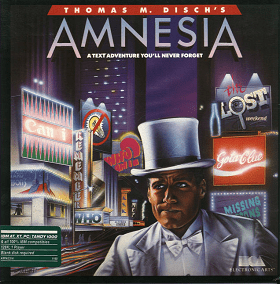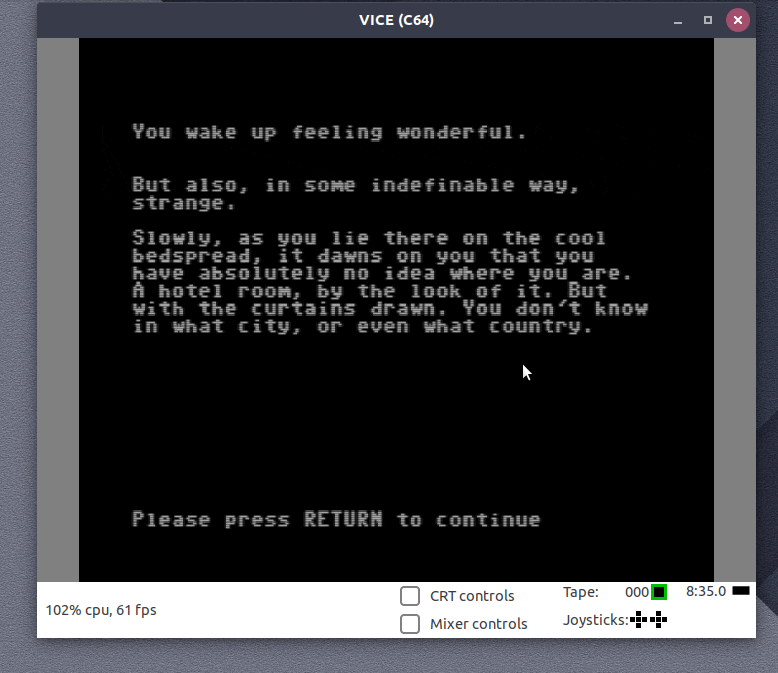By Alice Prael and Ethan Gates
In 1986 the science fiction author, Thomas M. Disch published the text based video game titled “Amnesia.” The game begins when the player’s character awakens in a hotel room in midtown Manhattan with no memory. The character must reveal his own life story in order to escape an attacker and prove he never killed anyone in Texas. The game was produced for IBM PC, Apple II and Commodore 64.
 In 1991 the Beinecke Rare Book and Manuscript Library acquired the papers of Thomas M. Disch; including his writings, correspondence, and ten 5.25-inch floppy disks, containing multiple versions of the video game titled “Amnesia”.
In 1991 the Beinecke Rare Book and Manuscript Library acquired the papers of Thomas M. Disch; including his writings, correspondence, and ten 5.25-inch floppy disks, containing multiple versions of the video game titled “Amnesia”.
In 2019 the Digital Archivist for Yale Special Collections, that’s me, Alice Prael, was searching for born digital archival material to test emulating legacy operating systems – like IBM PC, Apple II and Commodore 64. Funnily enough, the collection of born digital material I immediately remembered was titled “Amnesia”.
This fascinating game preserves a moment in video game development from the mid 1980s and presents an accurate reflection of 1986 midtown Manhattan, complete with shop names and correct opening and closing times. The production of the game for three different operating systems, makes it a great example for testing emulation capabilities. Fortunately, the content from these floppy disks had already been captured by the Digital Accessioning Support Service (DASS) in 2016. Unfortunately, the initial content capture was not entirely successful. The DASS captured the Kryoflux stream files and when disk imaging failed twice the DASS moved onto the next disk.
Quick Jargon Check: A disk image is a file that contains the contents and structure of a disk, it’s an exact copy of the disk without the physical carrier. When disk imaging is successful, the image can be mounted on your computer and opened like an attached flash drive to view the file system and contents.
Kryoflux stream files capture the magnetic flux on a floppy disk – which can then be interpreted into one of the 29 disk image formats. The stream files cannot be mounted and viewed like a file system, they can only be interpreted through the Kryoflux software. However, once Kryoflux interprets the stream files into the correct image format, that disk image can then be mounted to view the files. Now back to our story.
Since the stream files serve as a preservation copy, the DASS only tries two disk image formats before moving on. In order to use Amnesia as a test case, the stream files had to be re-interpreted into the one correct disk image format out of the 29 formats supported by Kryoflux – but which one? I started with the Commodore 64 version of the game. 14 Kryoflux disk image formats begin with CBM (Commodore Business Machines) so I started there. After some initial research to learn the history of image formats like “CMB V-MAX!” and “CBM Vorpal” I decided it would be much faster to try them all and see which ones worked. I created 14 disk images and attempted to mount each one to view the contents. 13 of them were mountable disk images. The game’s reliance on legacy operating systems makes it an ideal case for access via emulation, but that also means that the content isn’t readable like a normal file system full of text files. When I loaded the disk images I couldn’t make out full sentences, but a few of the mounted disk images revealed fully formed words like “hat”,“hamburger”, and “umbrella” – already proving more successful than the initial disk imaging in 2016.
From here I handed the disk images off to the Software Preservation Analyst, Ethan Gates, so I’ll let him tell the rest of the story.
Since I was largely unfamiliar with Commodore computing before this test case, I was slightly intimidated by the number of even partially-mountable images to test. But I had the same realization as Alice – rather than diving straight into the deep end of trying to understand each image format, it was faster to just try to plug each image into an emulator and see if the program could narrow the field for us. (Emulators are applications that mimic the hardware and software of another computer system – they can let you run Windows 95 on a Mac, or an Atari on your Intel PC, or much much more)
So, in a testing session with Claire Fox (a student in NYU’s Moving Image Archiving and Preservation M.A. program and our summer intern in Digital Preservation Services), we fired up VICE, an open source Commodore 64 emulator that we also use for the EaaSI project. When “attaching” a disk image (simulating the experience of inserting a floppy disk into an actual Commodore computer), VICE automatically gives a sense of whether the emulator can read the contents of that image:
Out of all the disk images Alice provided, VICE only seemed able to see the “Amnesia” program on 3 of them (“Amnesia” was distributed by Electronic Arts, hence the labeling). One (“CBM DOS”) simply froze on an image of the EA logo when attached and run. Two others – both flavors of “CBM GCR” – successfully booted into the game.
 We proceeded a ways into the game (until getting stumped by the first puzzle, at least) in order to be confident that the content and commands were working, and to compare whether the two images seemed to behave the same way. They did, which meant it was time to finally do some proper research and figure out the difference between these two formats that Kryoflux offered, and which one we should move forward with using for emulation.
We proceeded a ways into the game (until getting stumped by the first puzzle, at least) in order to be confident that the content and commands were working, and to compare whether the two images seemed to behave the same way. They did, which meant it was time to finally do some proper research and figure out the difference between these two formats that Kryoflux offered, and which one we should move forward with using for emulation.
Per the Kryoflux and VICE manuals, we learned that “CBM GCR” (or “G64”) disk image format was originally designed specifically for use with Commodore emulators by the teams behind VICE and CCS64 (another popular application). It is a flexible, “polymorphic” format whose main benefit is that it can help foil a number of copy protection methods – tricks that publishers like EA used to prevent users from copying their commercial floppies over to blank disks – the 1980s version of digital right management (DRM), essentially. The second CBM GCR option is the same format “plus mastering data needed for rewriting” – near as I can tell, this is only necessary for writing the disk image back out to a “new” 5.25-inch floppy, which I doubt will be in Yale’s use case. We’ll proceed with our first CBM GCR disk images for offering access to the Commodore 64 version of “Amnesia”.
This is very exciting progress, and we have been able to run “Amnesia” in a web browser using VICE in the Emulation-as-a-Service platform as well. Part of the fun moving forward will be deciding exactly what it should look like when presented to Beinecke patrons: VICE can actually recreate not just the Commodore 64, but a large range of other 8-bit Commodore models, as well as a number of aesthetic tweaks recreating a CRT display (brightness, contrast, scan lines, etc.) all of which can slightly alter the game’s appearance (OK, the difference is very slight with a text-based game, but still). VICE’s default options clearly do the heavy lifting to bring Disch’s work to life, but how important are these choices for design and context?
A further challenge will be working with the versions of “Amnesia” for systems beyond the Commodore. Kryoflux’s available formats for IBM PC and Apple II disk images do not handle EA’s copy protection schemes as well as their Commodore options, and so far we have not been able to create a usable disk image for either. It would be fascinating to be able to jump back and forth between multiple versions of the game in emulation to see how the text may have subtly changed, but that will require more investigation into properly converting emulatable copies from the preservation stream files.


Pingback: First endowment for digital preservation spotlights a rising need—and Yale Library expertise